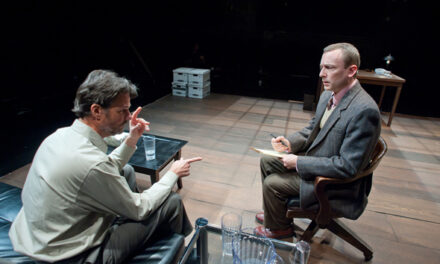Two shining stars in the firmament of music departments at University of North Carolina schools shone brightly in music of Mendelssohn as UNC-Chapel Hill ‘cellist Brent Wissick and UNC-Greensboro pianist Andrew Willis joined in a superbly-played recital on the campus of UNC-Chapel Hill.
Past collaborations have made these two artists thoroughly comfortable with each other in chamber music; each responds to the other’s nuanced playing as they create some of the finest performances I’ve been privileged to hear. While tonight’s program, as a university offering, was free, it exceeded in musical value many performances for which high ticket prices are the norm.
The program included Felix Mendelssohn’s (1809-1847) complete works for ‘cello and additional works by J.S. Bach (in arrangements by Robert Schumann and Ignaz Moscheles) and Fanny Mendelssohn Hensel, Felix’s sister.
Both Wissick and Willis are noted experts in historical performance practices; for this program, Wissick played an anonymous late 19th-century German violoncello, using gut strings. Willis played a modern (Regier, 1994) copy of an 1820 Graf fortepiano. To hear these works on these instruments is to imagine being in the Mendelssohn salon and hearing that talented family share their artistry and their music with their friends.
The well-constructed program featured three major works (the Op. 45 Sonata in B-flat, the Variations Concertantes, Op. 17, and the Sonata in D, Op. 58), separated by brief “salon-type” pieces. The B-flat sonata was time for adjusting one’s ears to the 19th-century balance between the period instruments: the fortepiano less assertive than the modern piano; the ‘cello’s gut strings less intense than the wire-wound strings of usual contemporary performance. It is even possible for the ‘cello to dominate the sound now-and-then, which rarely happens when that instrument is partnered with a modern grand piano. Likewise, the ‘cello’s pizzicato notes, so evident in the 2nd-movement Andante, were resonantly clear, blending perfectly amidst the fortepiano’s lines. The sonata’s final movement, Allegro assai, was full of Mendelssohn’s singing melodic lines, shared equally by both instruments.
Two novelty pieces came next: the “Bourrée” from J.S. Bach’s Suite in C for unaccompanied ‘cello, but with a piano accompaniment by Schumann, and the “Prelude in C” from Bach’s Well-Tempered Clavier, with a ‘cello obbligato by Moscheles, who paid homage to the Baroque master by adding ‘cello parts to ten of the WTC preludes. Both Schumann and Moscheles were contemporaries of Mendelssohn; their pieces were included to show how composers of their time were not only familiar with Bach’s music, but also wanted to use it within their own emerging compositional styles. Unlike the more familiar and slow Charles Gounod “Ave Maria” vocal obbligato version of the WTC prelude, Moscheles specified a much faster tempo for his setting, giving a brighter version of Bach’s music than is usually heard.
The Op. 17 variations, like Mendelssohn’s well-known Variations Sérieuses for solo piano, show the composer’s consummate skill in this form. Written for Felix’s younger brother, Paul (who was not a professional musician, but nevertheless shared his siblings’ musical talents), the variations explore the range of expression of both ‘cello and keyboard. Of special note were the 5th variation, with its “vivace” pizzicato ‘cello part, the 6th variation’s lyricism, and the 7th variation’s keyboard part’s virtuosity, which produced the fortepiano’s most forte sounds of the recital.
Wissick’s always-enlightening verbal program notes, added to the brief written note by ‘cellist Timothy Holley of NC Central University, introduced the three salon pieces which ended the recital’s first half. The first was a recently-discovered and previously unpublished gem which Mendelssohn dedicated to his successor as music director in Dusseldorf. Titled simply Albumblatt (“Album page”), this brief lyrical work was followed without pause by the Op. 109 Song Without Words, one of the many pieces by this title that Mendelssohn imbued with his unsurpassed gift of melody. The third salon piece was Nach Suden (“To the South”), by Fanny Mendelssohn Hensel. Had her father, and the times, been more open to women having careers and lives outside the home, Fanny may well have been as famous as Felix, for her compositional talents rivalled his. Wissick brought warm lyricism to each of these three all-too-brief delights.
After intermission, the program concluded with the Sonata in D, Op. 58. Its opening Allegro assai vivace, like so much of Mendelssohn’s keyboard writing, makes pianists wish to be paid by the note – cascades of scintillating arpeggios provide the canvas on which the ‘cello paints its vivid melodies. This was followed by the delightful Allegretto scherzando, this time with Willis taking the melodic lead and Wissick’s resonant pizzicato notes providing succinct commentary.
The Adagio, with its choral-like introspection, and the brilliant playing of the concluding Molto Allegro e vivace, left the packed recital hall crowd aglow with appreciation of the music and of its interpreters.
You will not hear better music-making than this. Congratulations to UNC-Chapel Hill for supporting and encouraging Professor Wissick as a member of its music faculty for over three decades, and for inviting Prof. Willis to make the journey from UNC-Greensboro to join his talents as a guest artist in this program. A number of their students were present to continue their education by being inspired by their teachers: proof that not all education is a business, but rather the nurture of creativity and the joining of past with present in the enrichment of life.











